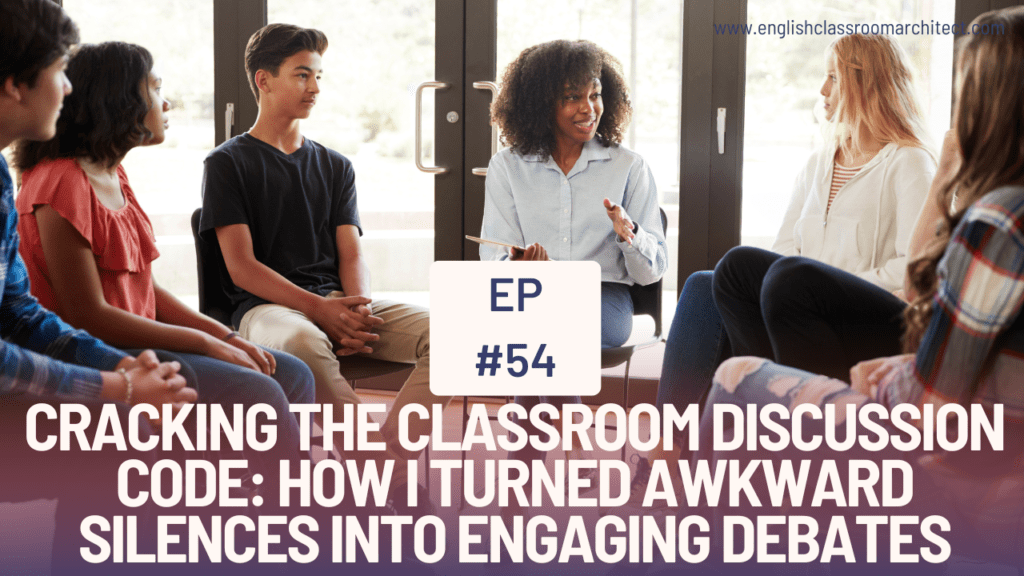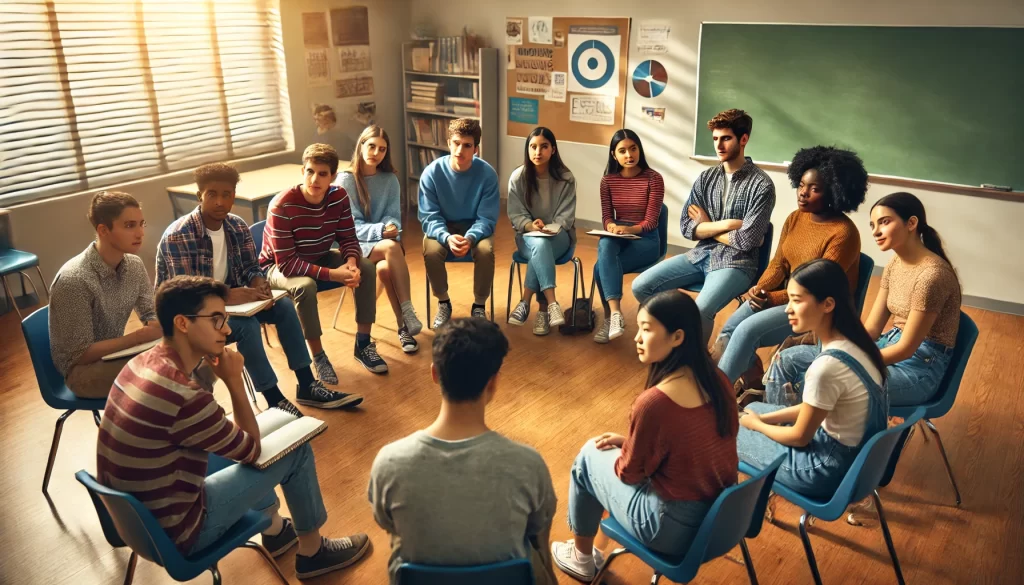
Ever faced a sea of blank stares during class discussions? You’re not alone. In this episode I explore my practices and habits that practices that were hindering class discussion and how I rethought assessment and scaffolding so my ideas and strategies have evolved to encourage all voices are heard.
Let’s turn those crickets into conversations and make your class the one students can’t stop talking about – literally.
Mentioned in this episode: 15. Elevating Socratic Seminars with Team-Based Approaches: Unleashing Collaboration and Competition

Table of Contents
Additional Resources
Key Concepts
- The evolution of classroom discussion techniques
- Importance of scaffolding in preparing students for high-level discussions
- Impact of grading strategies on student participation
- Accommodating diverse learning and processing styles in discussions
- The role of preparation and reflection in improving discussion quality
- Strategies for managing dominant voices and encouraging shy students
- The use of technology to enhance classroom discussions
Episode Timestamps
- – 00:02 – Introduction and contrast between early career and current classroom discussions
- – 01:59 – Early attempts at implementing Socratic seminars
- – 06:47 – Realizing the need for change in discussion facilitation
- – 07:19 – Successful group discussions during A Tale of Two Cities project
- – 09:56 – Understanding reasons for student disengagement in discussions
- – 13:17 – Introduction of back-channeling and its benefits
- – 15:58 – Accommodating different processing styles in discussions
- – 17:44 – The importance of comprehensive preparation for discussions
- – 21:55 – Evolving assessment strategies for discussions
- – 27:23 – Reflection on the ongoing evolution of classroom discussions
- – 28:24 – Preview of upcoming curriculum lab episode
Opportunities for Discussion
- How can teachers effectively scaffold discussions to ensure all students are prepared to participate?
- What strategies have you found successful in encouraging shy or reluctant students to engage in classroom discussions?
- How can we balance the need for structure with allowing organic, student-led conversations to develop?
- In what ways can technology be integrated into discussions without becoming a distraction?
- How might we adapt our assessment strategies to encourage meaningful participation rather than just frequency of contribution?

Detailed Breakdown of Classroom Discussion Improvement Strategies
1. Back-Channeling
Back-channeling involves creating a digital space where students can contribute thoughts and ideas concurrent with the main discussion. This strategy offers several benefits:
- Engages shy or introverted students who may be hesitant to speak up in class
- Provides a platform for real-time reflection and idea generation
- Allows students to process information at their own pace
- Creates a record of thoughts and ideas that can be revisited later
To implement back-channeling:
- Choose a suitable platform (e.g., Meet, Padlet, or even a shared Google Doc)
- Set clear guidelines for appropriate use
- Integrate back-channel contributions into the main discussion
2. Inner and Outer Circles
This discussion format involves dividing the class into two groups:
- Inner circle: Actively participates in the verbal discussion
- Outer circle: Observes, takes notes, and may participate via back-channel
Benefits include:
- Reduces pressure on students who are uncomfortable speaking in large groups
- Provides opportunities for focused listening and observation
- Allows for targeted feedback and reflection
Rotate students between inner and outer circles to ensure everyone has a chance to participate in both roles.
3. Comprehensive Preparation
Thorough preparation is crucial for successful discussions. This involves:
- Developing thought-provoking questions in advance
- Aligning pre-discussion assignments with final discussion topics
- Providing students with necessary background information and resources
- Teaching and practicing discussion skills explicitly
By front-loading much of the cognitive work, students come to discussions ready to engage deeply with the material and each other.
4. Scaffolding Prompts
Offering scaffolding prompts can help students initiate and sustain meaningful discussions. Examples include:
- Sentence starters: “I agree/disagree with… because…”
- Question stems: “How does this connect to…?”
- Conversation strategies: “Can you elaborate on that point?”
Gradually reduce the use of these prompts as students become more confident in their discussion skills.
5. Revised Assessment Strategies
Rethinking how we assess participation can dramatically impact the quality of discussions:
- Move beyond quantity-based grading (e.g., counting number of contributions)
- Assess quality of contributions and how students build on others’ ideas
- Include peer and self-assessment components
- Set both individual and group discussion goals
Consider using a rubric that includes criteria such as:
- Depth of analysis
- Use of textual evidence
- Ability to ask probing questions
- Skill in drawing others into the conversation
6. Managing Group Dynamics
Addressing group dynamics is crucial for fostering inclusive and productive discussions:
- Establish clear norms and expectations for respectful dialogue
- Teach strategies for respectfully disagreeing or challenging ideas
- Address dominant voices through individual feedback and structured participation opportunities
- Encourage quieter students through low-stakes participation options (e.g., think-pair-share before whole group discussion)
7. Reflection and Continuous Improvement
Regular reflection helps both teachers and students improve their discussion skills:
- Implement post-discussion reflections for students
- Analyze what went well and areas for improvement after each discussion
- Seek student feedback on discussion formats and topics
- Continuously adapt strategies based on the needs of each unique group of students
By viewing the art of discussion as an ongoing journey of improvement, both teachers and students can work together to create increasingly meaningful and engaging classroom conversations.
Free Classroom Discussion Toolkit
To help you implement the strategies discussed in this episode, check out this free Discussion Toolkit. This comprehensive resource includes:
- Classroom discussion frameworks and techniques
- Sentence stems and question formulation starters
- Other classroom discussion supports
- Classroom discussion games
- Templates for note-taking, reflection, and assessment
This toolkit is designed to give you practical, ready-to-use tools to enhance classroom discussions and student engagement.
More About Improving Classroom Discussions
Enhancing classroom discussions is a crucial skill for educators looking to create engaging, student-centered learning environments. Here’s what we’ve learned through exploring these techniques:
- Preparation is key: Successful discussions don’t happen by chance. Invest time in preparing students with the necessary background knowledge, vocabulary, and discussion skills before diving into complex topics.
- Scaffold for success: Provide students with discussion prompts, sentence starters, or pre-discussion activities to help them organize their thoughts and feel more confident contributing.
- Embrace technology thoughtfully: Tools like digital back-channels can provide alternative ways for students to engage, particularly those who may be hesitant to speak up in class. However, ensure that technology enhances rather than distracts from the core discussion.
- Foster a safe environment: Create a classroom culture where students feel comfortable taking risks, sharing incomplete ideas, and respectfully challenging each other’s thinking.
- Reflect and improve: Regularly ask students to reflect on their participation and the quality of class discussions. Use this feedback to continually refine your approach and address any issues that arise.
By implementing these strategies, you can transform your classroom into a space where vibrant, meaningful discussions become the norm rather than the exception.
Follow @englishclassroomarchitect on Instagram for more innovative teaching strategies and resources.
